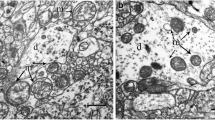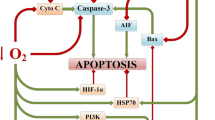Abstract
We examined the role of hypoxia in the carbon monoxide (CO)-induced generation of the hydroxyl radical (•OH) in the striatum, which could contribute to brain damage due to CO poisoning. Exposure of free-moving rats to 1,000 and 3,000 ppm CO or 8 and 5% O2 for 40 min caused concentration-dependent hypoxic conditions in terms of carboxyhemoglobin (COHb), deoxyhemoglobin, oxyhemoglobin, and O2 contents in arterial blood. The hypoxic conditions seemed comparable between 3,000 ppm CO and 5% O2, although alterations of pH and partial O2 pressure (PO2) were complex and concentration independent. In the striatum, CO and low O2 decreased tissue PO2 levels in a concentration-dependent and concentration-independent manner, respectively, but levels at the end of exposure were comparable among all groups. This was also the case for the increase in striatal blood flow. Although the increases in extracellular glutamate (excitatory), taurine (inhibitory), and alanine (non-neurotransmitter), in the striatum in response to CO and low O2 were complex, 3,000 ppm CO and 5% O2 had comparable effects. Thus, 3,000 ppm CO and 5% O2 seemed to induce comparable hypoxic conditions. Nevertheless, the former more strongly stimulated •OH generation in the striatum than the latter. In addition, in contrast to low O2 which caused a concentration-dependent increase in •OH, 1,000 ppm CO had no effect. The findings suggest that striatal •OH generation due to CO poisoning may be independent of hypoxia per se and that a threshold might exist.




Similar content being viewed by others
References
Choi IS (1983) Delayed neurologic sequelae in carbon monoxide intoxication. Arch Neurol 40:433–435
Choi IS, Cheon HY (1999) Delayed movement disorders after carbon monoxide poisoning. Eur Neurol 42:141–144
Ernst A, Zibrak JD (1998) Carbon monoxide poisoning. New Engl J Med 26:1603–1608
Gale SD, Hopkins RO, Weaver LK, Bigler ED, Booth EJ, Blatter DD (1999) MRI, quantitative MRI, SPECT, and neuropsychological findings following carbon monoxide poisoning. Brain Inj 13:229–243
Gilgun-Sherki Y, Rosenbaum Z, Melamed E, Offen D (2002) Antioxidant therapy in acute central nervous system injury: current state. Pharmacol Rev 54:271–284
Ginsberg MD (1979) Delayed neurological deterioration following hypoxia. Adv Neurol 26:21–44
Ginsberg MD (1980) Carbon monoxide. In: Spencer PS, Schaumburg HH (eds) Experimental and clinical neurotoxicity. Williams and Wilkins, Baltimore, pp 374–394
Hampson NB, Hauff NM (2008) Carboxyhemoglobin levels in carbon monoxide poisoning: do they correlate with the clinical picture? Am J Emerg Med 26:665–669
Hara S, Mukai T, Kuriiwa F, Iwata N, Kano S, Endo T (1996) Local changes in oxygen tension and blood flow in the brain under hyperthermia induced by intracerebroventricular NMDA in rats. Brain Res 737:339–342
Hara S, Mukai T, Kurosaki K, Kuriiwa F, Endo T (2002) Modification of the striatal dopaminergic neuron system by carbon monoxide exposure in free-moving rats, as determined by in vivo brain microdialysis. Arch Toxicol 76:596–605
Hara S, Mukai T, Kurosaki K, Kuriiwa F, Endo T (2003) Characterization of suppression of nitric oxide production by carbon monoxide poisoning in the striatum of free-moving rats, as determined by in vivo brain microdialysis. Brain Res 979:27–36
Hara S, Mukai T, Kurosaki K, Kuriiwa F, Endo T (2004) Characterization of hydroxyl radical generation in the striatum of free-moving rats due to carbon monoxide poisoning, as determined by in vivo microdialysis. Brain Res 1016:281–284
Hara S, Mizukami H, Mukai T, Kurosaki K, Kuriiwa F, Endo T (2009) Involvement of extracellular ascorbate and iron in hydroxyl radical generation in rat striatum in carbon monoxide poisoning. Toxicology 264:69–73
Ingelman-Sundberg M, Kaur H, Terelius Y, Persson JO, Halliwell B (1991) Hydroxylation of salicylate by microsomal fractions and cytochrome P-450. Lack of production of 2,3-dihydroxybenzoate unless hydroxyl radical formation is permitted. Biochem J 276:753–757
Ishimaru H, Katoh A, Suzuki H, Fukuta T, Kameyama T, Nabeshima T (1992) Effects of N-methyl-D-aspartate receptor antagonists on carbon monoxide-induced brain damage in mice. J Pharmacol Exp Ther 261:349–352
Lancelot E, Revaud M-L, Boulu RG, Plotkine M, Callebert J (1998) A microdialysis study investigating the mechanisms of hydroxyl radical formation in rat striatum exposed to glutamate. Brain Res 809:294–296
Leker RR, Shohami E (2002) Cerebral ischemia and trauma—different etiologies yet similar mechanisms: neuroprotective opportunities. Brain Res Rev 39:55–73
Lewén A, Matz P, Chan PH (2000) Free radical pathways in CNS injury. J Neurotrauma 17:871–890
MacMillan V (1975) Regional cerebral blood flow of the rat in acute carbon monoxide intoxication. Can J Physiol Pharmacol 53:644–650
Nabeshima T, Katoh A, Ishimaru H, Yoneda Y, Ogita K, Murase K, Ohtsuka H, Inari K, Fukuta T, Kameyama T (1991) Carbon monoxide-induced delayed amnesia, delayed neuronal death and change in acetylcholine concentration in mice. J Pharmacol Exp Ther 256:378–384
O’Donnell P, Buxton PJ, Pitkin A, Jarvis LJ (2000) The magnetic resonance imaging appearances of the brain in acute carbon monoxide poisoning. Clin Radiol 55:273–280
Olano M, Song D, Murphy S, Wilson DF (1995) Relationships of dopamine, cortical oxygen pressure, and hydroxyl radicals in brain of newborn piglets during hypoxia and posthypoxic recovery. J Neurochem 65:1205–1212
Ooboshi H, Ibayashi S, Takano K, Sadoshima S, Kondo A, Uchimura H, Fujishima M (2000) Hypothermia inhibits ischemia-induced efflux of amino acids and neuronal damage in the hippocampus of aged rats. Brain Res 884:23–30
Paxinos G, Watson C (1998) The rat brain in stereotaxic coordinates. Academic Press, San Diego
Phillis JW, Song D, O’Regan MH (1997) Inhibition by anion channel blockers of ischemia-evoked release of excitotoxic and other amino acids from rat cerebral cortex. Brain Res 758:9–16
Piantadosi CA (1999) Diagnosis and treatment of carbon monoxide poisoning. Res Care Clin N Am 5:183–202
Piantadosi CA, Zhang J, Demchenko IT (1997) Production of hydroxyl radical in the hippocampus after CO hypoxia or hypoxic hypoxia in the rat. Free Rad Biol Med 22:725–732
Sayre LM, Perry G, Smith MA (2008) Oxidative stress and neurotoxicity. Chem Res Toxicol 21:172–188
Smith TS, Bennett JP Jr (1997) Mitochondrial toxins in models of neurodegenerative diseases. I: in vivo brain hydroxyl radical production during systemic MPTP treatment or following microdialysis infusion of methylpyridinium or azide ions. Brain Res 765:183–188
Van Hemelrijck A, Sarre S, Smolders I, Michottem Y (2005) Determination of amino acids associated with cerebral ischaemia in rat brain microdialysates using narrowbore liquid chromatography and fluorescence detection. J Neurosci Methods 144:63–71
Varma DR, Mulay S, Chemtob S (2009) Carbon monoxide: from public health risk to painless killer. In: Gupta RC (ed) Handbook of toxicology of chemical warfare agents. Academic Press, New York, pp 271–292
Acknowledgments
This study was supported by a Grant-in-Aid for Scientific Research (C) (15590590 and 21590747) from the Ministry of Education, Science, Sports and Culture, Japan.
Conflict of interest
The authors declare that they have no conflict of interest.
Author information
Authors and Affiliations
Corresponding author
Rights and permissions
About this article
Cite this article
Hara, S., Mizukami, H., Kurosaki, K. et al. Existence of a threshold for hydroxyl radical generation independent of hypoxia in rat striatum during carbon monoxide poisoning. Arch Toxicol 85, 1091–1099 (2011). https://doi.org/10.1007/s00204-010-0637-2
Received:
Accepted:
Published:
Issue Date:
DOI: https://doi.org/10.1007/s00204-010-0637-2




